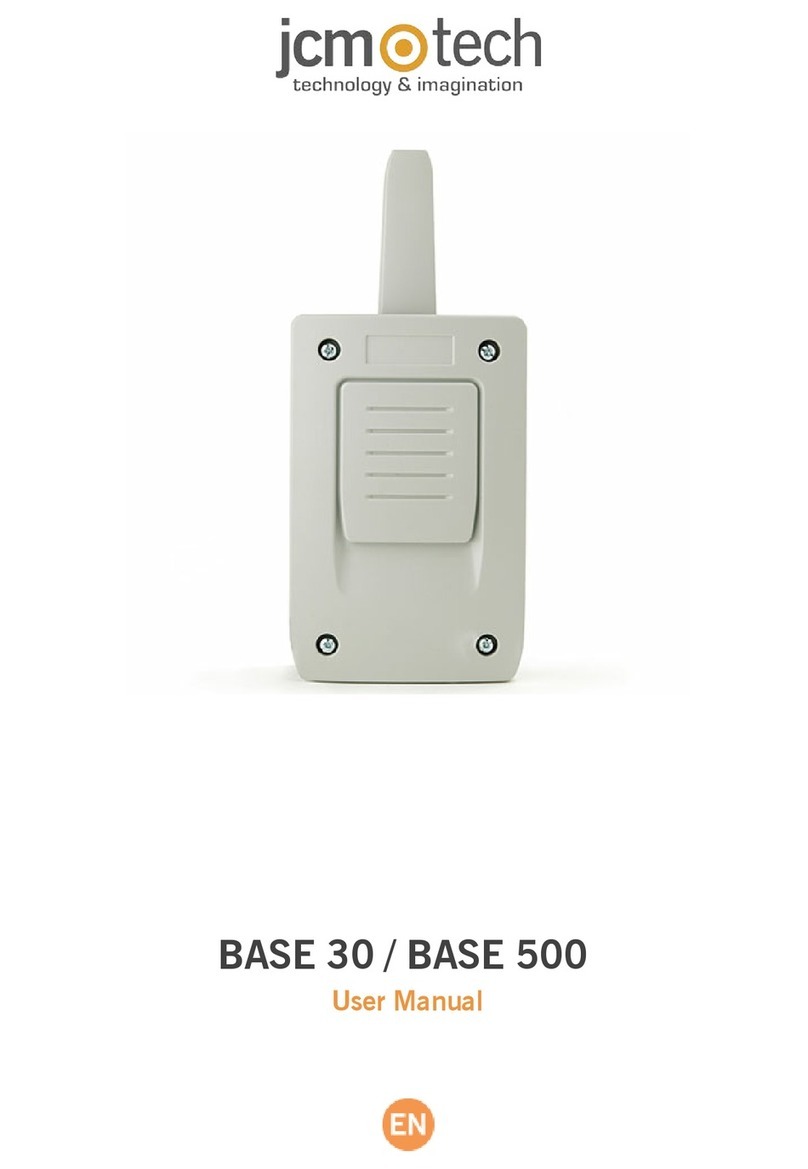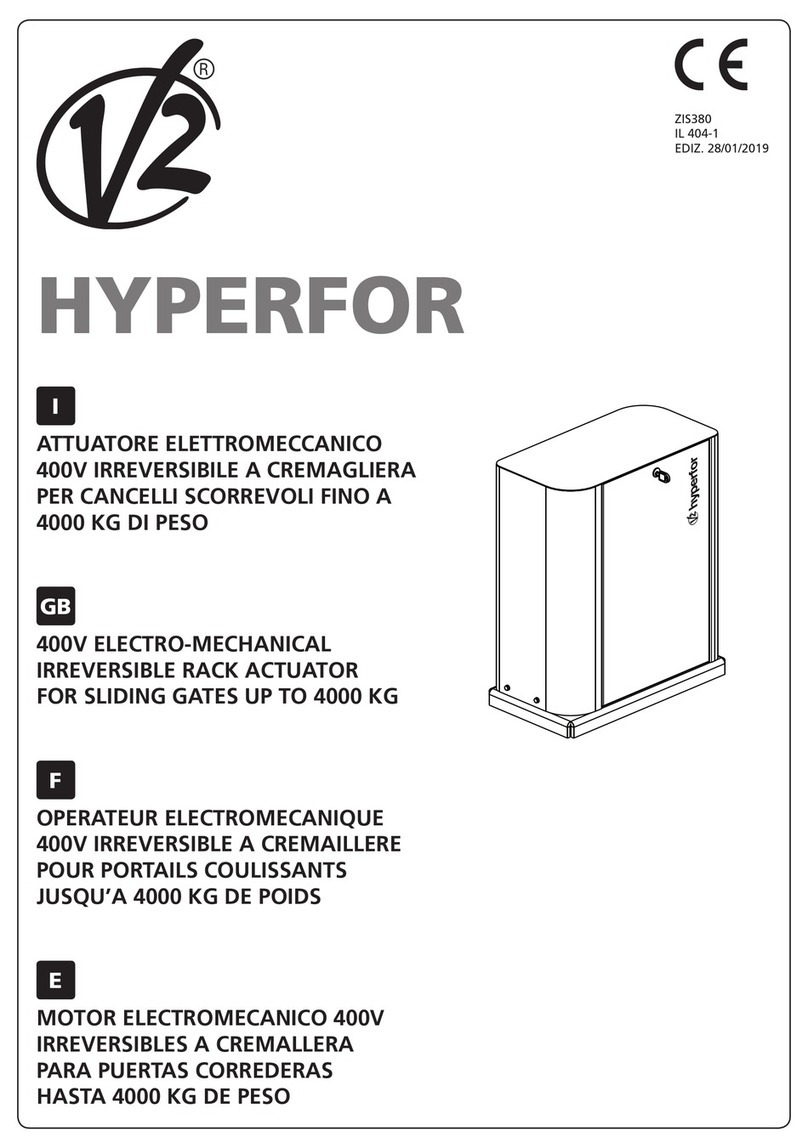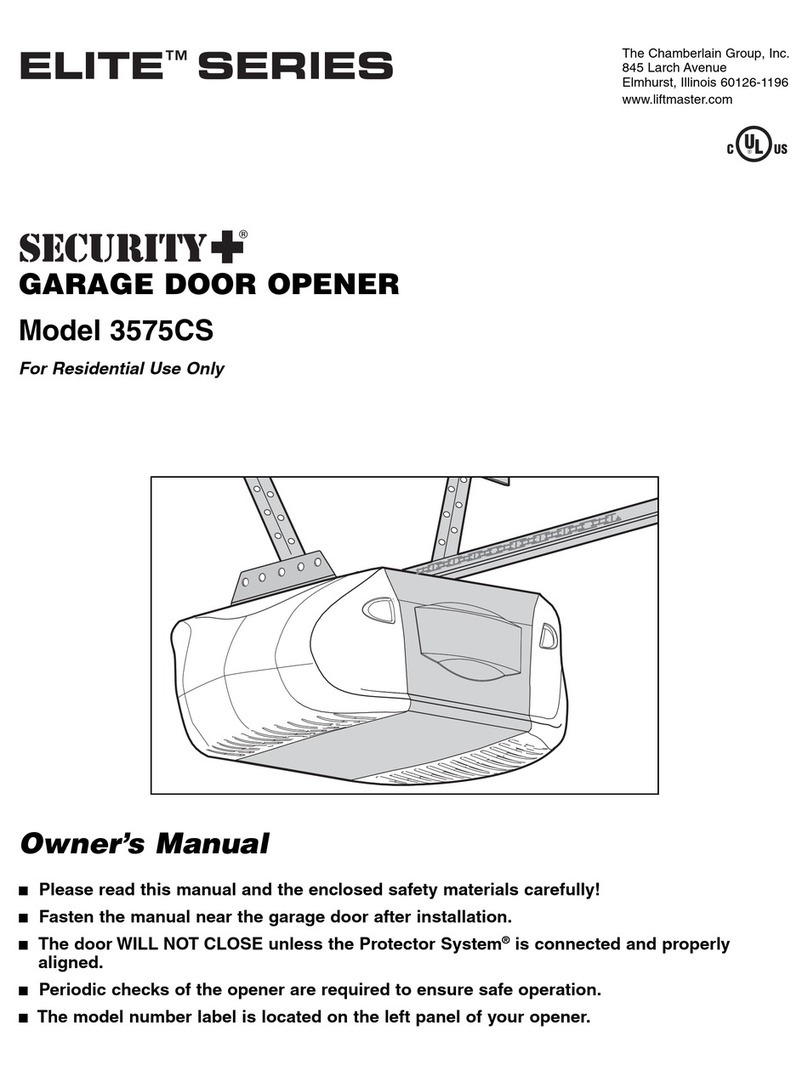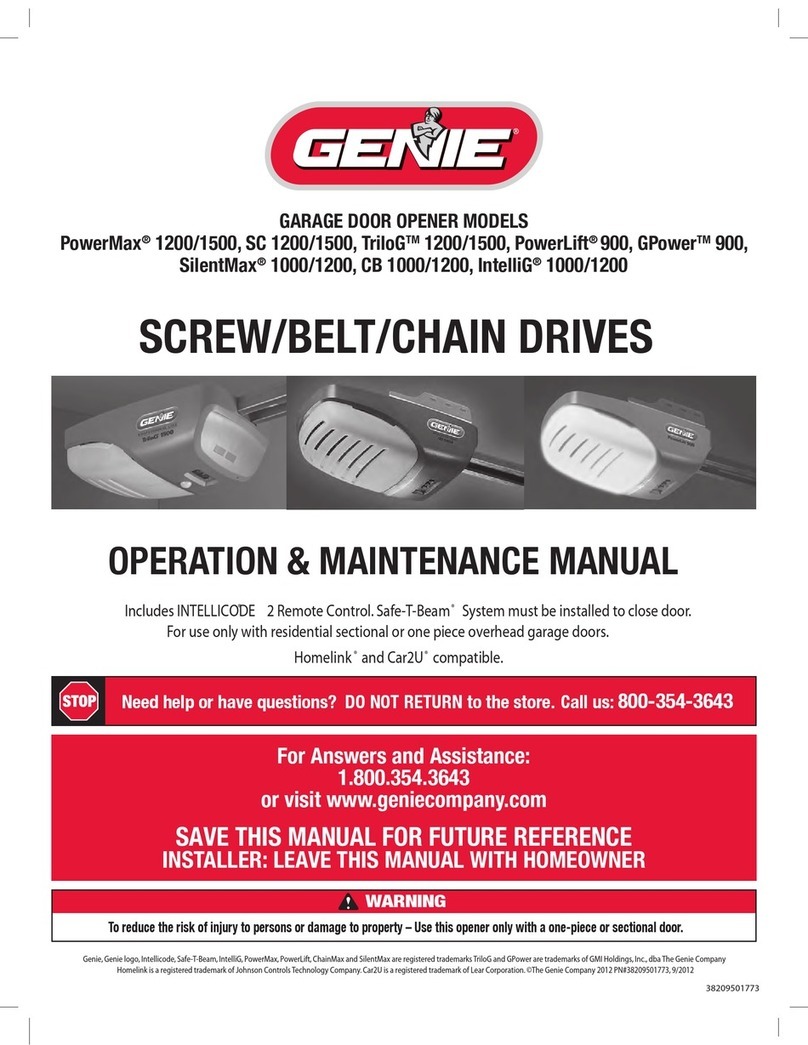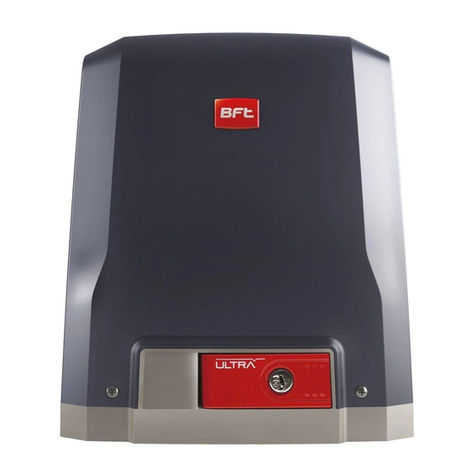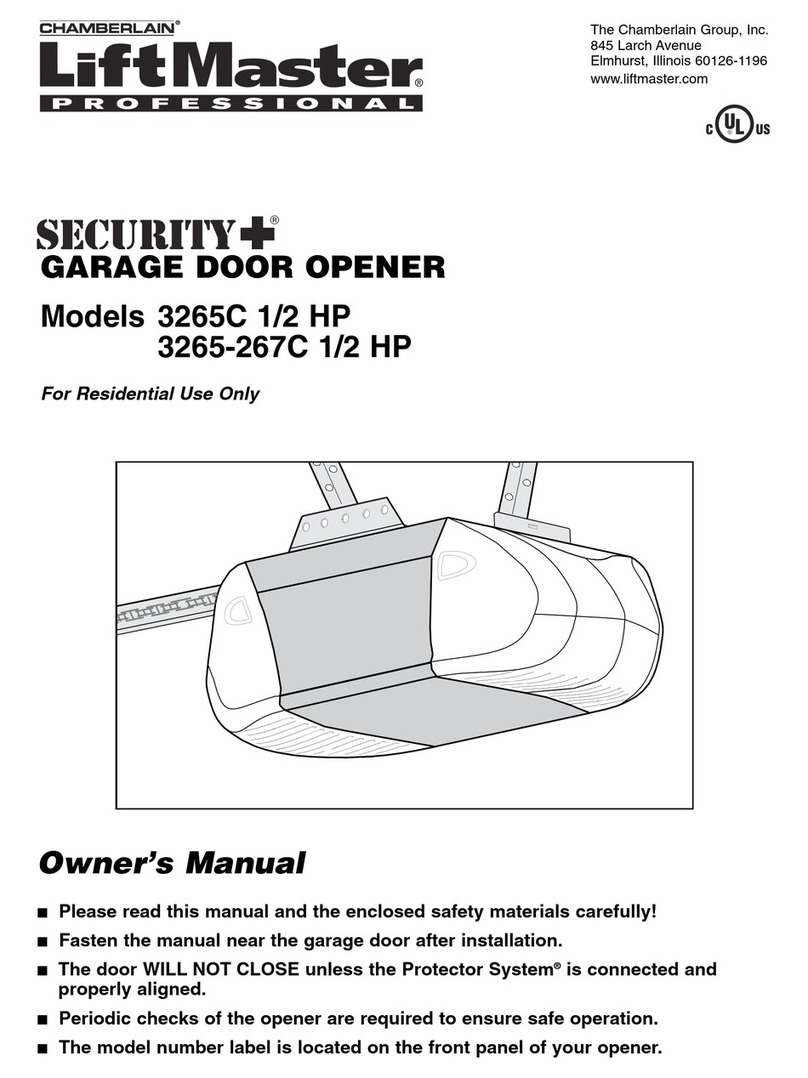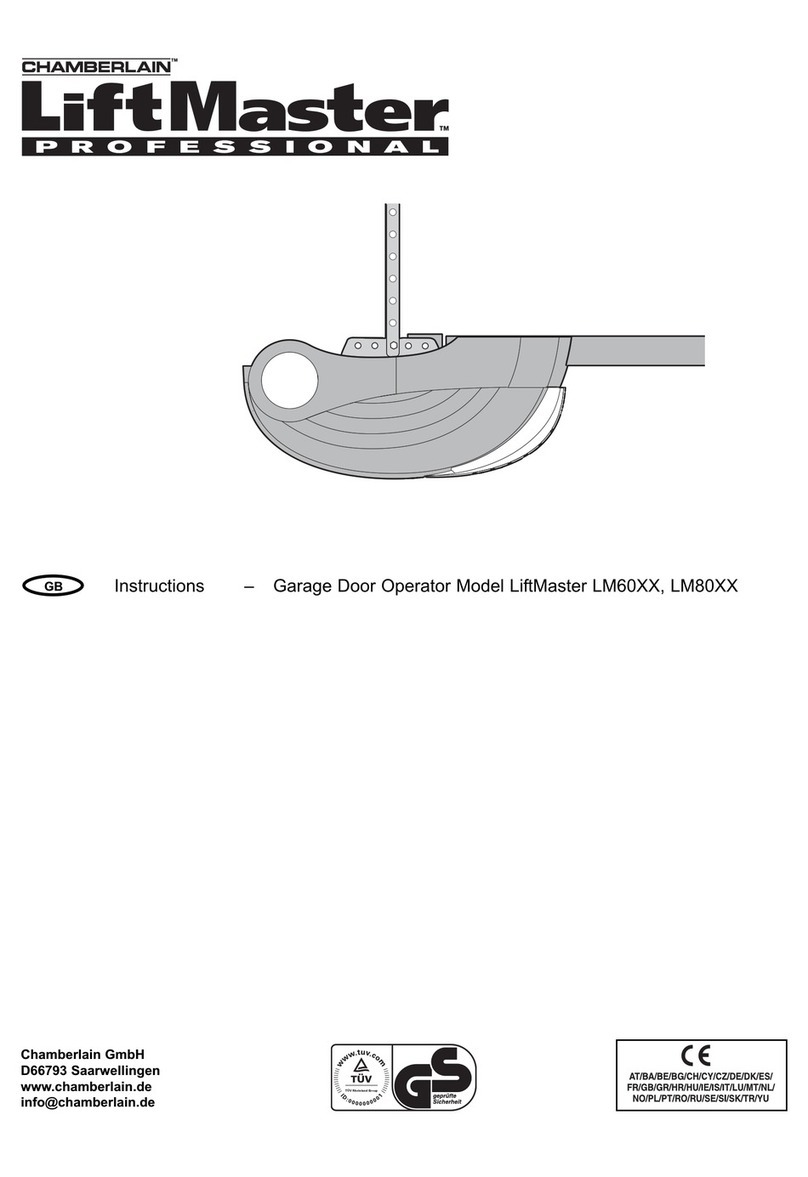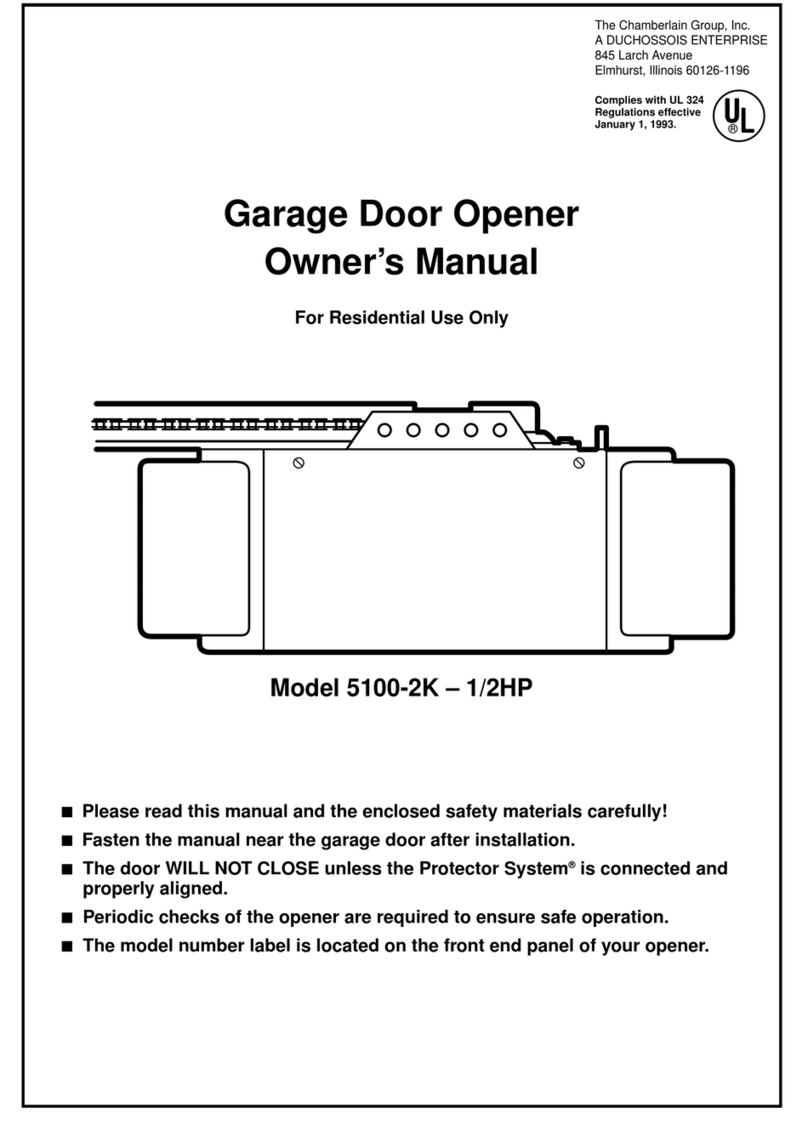Merik 501M-1/2HP User manual

Garage Door Opener
Owner’s Manual
FOR RESIDENTIAL USE ONLY
1/2HP
Model 501M - 1/2HP
CAUTION! PLEASE READ THIS MANUAL CAREFULLY!
The MODEL NUMBER label is located on the front panel of your opener.
CONTENTS PAGE
Safety Rules ................................................................2
Features of Your Opener.............................................3
Specifications ..............................................................3
You'll Need Tools.........................................................3
Completed Installation Illustration................................4
Operation of Your Opener ...........................................5
Accessories .................................................................5
Care & Maintenance of Your Opener ..........................6
Assembly Instructions..................................................7
Installation Instructions ..............................................10
Travel Limit Adjustments ...........................................20
CONTENTS PAGE
Force Adjustments ......................................................21
Safety Reverse Test....................................................22
The Protector System™..............................................22
Code Programming Instructions..................................23
Having a Problem?......................................................24
Carton Contents & Hardware Illustrated .....................26
Repair Parts, Rail Assembly .......................................26
Repair Parts, Installation .............................................26
Repair Parts, Opener Assembly..................................27
How To Order Repair Parts.........................................28
Warranty......................................................................28
FASTEN THIS MANUAL NEAR THE GARAGE DOOR AFTER INSTALLATION.
PERIODIC CHECKS OF THE OPENER ARE REQUIRED TO INSURE SATISFACTORY OPERATION.

THESE SAFETY ALERT SYMBOLS MEAN CAUTION - PERSONAL SAFETY, PROPERTY DAMAGE OR
DANGER FROM ELECTRIC SHOCK. READ THESE INSTRUCTIONS CAREFULLY.
THIS GARAGE DOOR OPENER IS DESIGNED AND TESTED TO OFFER REASONABLY SAFE SERVICE
PROVIDED IT IS INSTALLED AND OPERATED IN STRICT ACCORDANCE WITH THE FOLLOWING SAFETY
INSTRUCTIONS.
FAILURE TO COMPLY WITH THE FOLLOWING INSTRUCTIONS MAY RESULT IN SERIOUS PERSONAL
INJURY OR PROPERTY DAMAGE.
CAUTION: IF YOUR GARAGE HAS NO SERVICE ENTRANCE DOOR, INSTALL MODEL 1702E EMERGENCY RELEASE
KEYLOCK. THIS ACCESSORY ALLOWS MANUAL OPERATION OF GARAGE DOOR FROM OUTSIDE IN CASE OF
POWER FAILURE.
KEEP GARAGE DOOR BALANCED. Sticking
or binding doors must be repaired. Garage
doors, door springs, cables, pulleys,
brackets and their hardware are under
extreme tension and can cause serious
personal injury. DO NOT ATTEMPT TO
LOOSEN, MOVE OR ADJUST THEM. Call for
garage door service.
DISCONNECT ELECTRIC POWER TO
GARAGE DOOR OPENER BEFORE MAKING
REPAIRS OR REMOVING COVERS.
To avoid serious personal injury from
entanglement, REMOVE ALL THE ROPES
CONNECTED TO GARAGE DOOR before
installing the garage door opener.
DO NOT WEAR RINGS, WATCHES OR
LOOSE CLOTHING while installing or
servicing a garage door opener.
DISENGAGE ALL EXISTING GARAGE DOOR
LOCKS to avoid damage to garage door.
Installation and wiring must be in
compliance with your local building and
electrical codes. CONNECT THE POWER
CORD ONLY TO A PROPERLY GROUNDED
OUTLET.
Fasten a CAUTION LABEL to the wall
adjacent to the Door Control and the other
to the garage door, as reminders of safe
operating procedures.
THE SAFETY REVERSE SYSTEM TEST IS
VERY IMPORTANT (page 22). Your garage
door MUST reverse on contact with a 25mm
obstacle placed on the floor. Failure to
properly adjust the opener may result in
serious personal injury from a closing
garage door. REPEAT THE TEST ONCE A
MONTH AND MAKE ANY NEEDED
ADJUSTMENTS.
LIGHTWEIGHT DOORS OF FIBERGLASS,
ALUMINUM OR STEEL MUST BE SUB-
STANTIALLY REINFORCED TO AVOID
DOOR DAMAGE. (See page 17.) The best
solution is to check with your garage door
manufacturer for an opener installation
reinforcement kit.
Install door control (or any additional push
buttons) IN A LOCATION WHERE GARAGE
DOOR IS VISIBLE, BUT OUT OF THE REACH
OF CHILDREN. DO NOT ALLOW CHILDREN
TO OPERATE PUSH BUTTON(S) OR
REMOTE CONTROL TRANSMITTER. Serious
personal injury from a closing garage door
may result from misuse of the opener.
CAUTION: Activate opener only when the
door is in full view, free of obstructions and
opener is properly adjusted. NO ONE
SHOULD ENTER OR LEAVE THE GARAGE
WHILE DOOR IS IN MOTION. DO NOT
ALLOW CHILDREN TO PLAY NEAR THE
DOOR.
Use the manual release ONLY to disengage
the trolley and, if possible, ONLY when the
door is closed. DO NOT USE THE RED
HANDLE TO PULL DOOR OPEN OR
CLOSED.
2
Start By Reading These Important Safety Rules
DO NOT USE THE FORCE ADJUSTMENTS
TO COMPENSATE FOR A BINDING OR
STICKING GARAGE DOOR. Excessive
force will interfere with the proper
operation of the safety reverse system or
damage the garage door (page 21).

Before you begin, please check the contents of the cartons. Illustrations of parts and hardware are
shown on pages 26 and 27. Separate the hardware for assembly and installation as shown.
SPECIFICATIONS
Pliers
Wire Cutters
Claw Hammer
Hack Saw
Screwdriver Adjustable End Wrench
Socket Wrench
Electric Drill
Tape Measure
2
1
Stepladder
Carpenter’s
Level
Pencil
5 mm & 8mm
Drill Bits
YOU'LL NEED TOOLS
During assembly and installation of your opener, the instructions will call for the use of various hand
tools shown below.
FEATURES OF YOUR OPENER
1. Opener Lights: Turn on and off automatically
with 4-1/2 minute illumination for your safety and
convenience.
2.Manual Disconnect: Pull cord disconnect
permits manual door operation in case of an
emergency or power failure.
3. Automatic Reconnect: Trolley halves reconnect
for automatic operation when opener is activated
after a manual disconnect.
4. Safety System: Independent up and down force
adjustment. The door REVERSES automatically
when obstructed in DOWN direction. The door
STOPS when obstructed in UP direction.
5. Motor: Permanently lubricated with automatic
reset.
6. Easy Limit Adjustment: Limits of door opening
and closing adjusted by turning screws without
removing opener cover.
MOTOR
Type ............................Permanent split capacitor
Speed..........................1500 rpm
Volts ............................120 Volts AC - 60 Hz. Only
Current ........................4.5 Amperes
DRIVE MECHANISM
Gears ..........................16:1 worm gear reduction
Drive............................Chain and cable with one-piece
trolley on steel T-rail
Length of travel ...........Adjustable to 2.29m.
Travel rate ...................15-20cm per second
Lamp ...........................On when door starts to travel, off
4-1/2 minutes after stop.
Door linkage................Adjustable door arm. Pull cord
trolley release.
SAFETY
Personal.......................Push button and automatic reversal
in down direction. Push button and
automatic stop in UP direction
Electronic.....................Independent UP and DOWN force
adjustment screws
Electrical......................Motor overload protector & low
voltage push button wiring
Limit device..................Circuit actuated by limit nut
Limit adjustment ..........Screwdriver adjustment on side
panel
Start circuit...................Low voltage push button or radio
control
DIMENSIONS
Length (overall)............3.15m
Headroom required .....5cm
Hanging weight............14.5kg
3

BEFORE YOU BEGIN, PLEASE TAKE SOME TIME TO CAREFULLY EXAMINE THE ILLUSTRATIONS OF AS
TYPICAL GARAGE DOOR OPENER INSTALLATION ON BOTH A SECTIONAL AND A ONE-PIECE DOOR.
Some installation instructions vary for sectional and one-piece doors. Follow only those instructions which apply
to your door type.
Do you have a finished ceiling in your garage? If so, you will need a support bracket and additional fastening
hardware. Refer to Step 5, Page 14 for specific requirements.
Do you have a lightweight or metal door (or does it have glass panels)? If so, horizontal and vertical
reinforcement is required. Refer to Step 10, Page 17.
If possible, install the door opener 2.1m or more above floor with the manual release handle mounted
1.8m above the floor.
4
Horiazontal &Vertical
Support - Not Supplied
(Needed Only for
Lightweight Garage
Door Installation)
Cable
Pulley
Bracket
Header Bracket
Trolley
Straight
Door
Arm Manual
Trolley
Release
Door Bracket
Door
Curved
Door
Arm
Garage
Dooor
Spring
Header
Chain
Horizaontal
Garage Door
Reinforcement
(if needed)
Vertical Garage Door
Reinforcement (if needed)
Support Bracket
and Fastening Hardware
(Not Supplied)
Cable Pulley
Bracket
Header
Bracket
Trolley
Straight
Door
Arm
Manual
Trolley
Release
Door Bracket
Curved
Door
Arm
Header Door
Chain
Cable
Cable
Support Bracket
and Fastening Hardware
(Not Supplied)
ONE-PIECE DOOR INSTALLATION
SECTIONAL DOOR INSTALLATION

Operation of Your Opener
CAUTION
TO ACTIVATE THE OPENER:
Use any of the following devices:
1. The Remote Control Transmitter. Hold the push
button down until the door starts to move.
2. The Door Control. Hold push button down until the
door starts to move.
3. Key Switch or Keyless Entry System accessories.
HOW TO OPERATE THE DOOR MANUALLY:
DOOR SHOULD BE FULLY CLOSED IF POSSIBLE.
WEAK OR BROKEN SPRINGS COULD ALLOW AN
OPEN DOOR TO FALL RAPIDLY. PROPERTY
DAMAGE OR SERIOUS PERSONAL INJURY
COULD RESULT. DO NOT USE MANUAL RELEASE
HANDLE TO PULL DOOR OPEN OR CLOSED.
Disconnect door from opener by pulling down sharply
on red handle. Lift door manually. To automatically
reconnect door to opener, press Door Control push
button.
LOCKOUT FEATURE: Prevents trolley from
reconnecting automatically. If you need to use this
feature, pull manual release handle down and back
(toward opener). Trolley will remain "Locked-Out" and
door can be raised and lowered manually. To reconnect
trolley, pull manual release handle straight down.
OPENER LIGHTS will turn on under the following
conditions: When the opener is initially plugged in;
when the power is interrupted; when the opener is
activated. Lights turn off automatically after 4-1/2
minutes or provide constant light when the Light
feature is activated. (75 watt maximum bulb.)
HOW DOOR MOVES WHEN OPENER ACTIVATES:
1. If open, door will close. If closed, the door will
open.
2. If closing, the door will reverse.
3. If opening, the door will stop (allowing space for
entry and exit of pets and for fresh air).
4. If the door has been stopped in a partially open
position, it will close.
5. If obstructed while closing, the door will reverse.
6. If obstructed while opening, the door will stop.
7. The optional Protector System™ uses an invisible
beam which, when broken by an obstruction, causes
a closing door to open and prevents an open door
from closing. It is STRONGLY RECOMMENDED for
homeowners with young children.
•BEFORE YOU PROCEED, PLEASE READ
SAFETY RULES ON PAGE 2 AND THE
OPERATING INSTRUCTIONS ON THIS PAGE
CAREFULLY.
• TO AVOID DIFFICULTY DURING INSTALLATION,
DO NOT RUN OPENER UNTIL INSTRUCTED TO
DO SO.
• DO NOT PERMIT CHILDREN TO PLAY IN THE
AREA OF THE DOOR.
• OPERATE ONLY WHEN OPENER IS PROPERLY
ADJUSTED AND THE DOOR IS VISIBLE AND
UNOBSTRUCTED.
ACCESSORIES AVAILABLE FOR YOUR OPENER
“The Protector System”:
Provides auxiliary support to the safety features built into your opener. The system’s invisible beam,
when broken by an obstruction, causes a closing door to open and prevents an open door from
closing.
Outdoor Key Switch:
Opens the garage door automatically
from outside with the turn of a key
when transmitter is not handy.
Keyless Entry System:
Enables the homeowner to operate
garage door opener from outside by
entering code on specially designed
keypad.
Single Function Remote Control
Transmitter:
Standard size, with visor clip.
5
Emergency Release Keylock:
REQUIRED for a garage with NO
service door.
Allows manual operation of garage
door from outside in case of power
failure.
Model 870CB
Model 750CB
Model 760CB Model 7702CB
Model 740CB

CARE OF THE OPENER
When properly installed, opener will provide high
performance with a minimum of maintenance. The
opener does not require additional lubrication.
Most complaints of unsatisfactory opener operation
can be traced to problems with the door itself. When
operated manually, a properly balanced door will stay
in any point of travel while being supported entirely by
its springs.
THE OPENER IS NOT INTENDED TO CORRECT
ANY PROBLEMS THAT ARE CAUSED BY AN
UNBALANCED OR BINDING DOOR, BROKEN
DOOR SPRINGS OR BY FAULTY DOOR
HARDWARE.
LIMIT AND FORCE ADJUSTMENTS: These
adjustments must be checked and properly set when
opener is installed. Only a screwdriver is required.
Pages 20 and 21 refer to the limit and force
adjustments. Follow the instructions carefully.
REPEAT THE SAFETY REVERSE TEST AFTER
ANY ADJUSTMENT. Weather conditions may cause
some minor changes in the door operation, requiring
some readjustments, particularly during the first year
of operation.
THE SAFETY REVERSE SYSTEM IS IMPORTANT
(see page 22). GARAGE DOOR MUST REVERSE
ON CONTACT WITH A 25mm OBSTACLE
PLACED ON THE FLOOR. FAILURE TO
PROPERLY ADJUST OPENER MAY RESULT IN
SERIOUS PERSONAL INJURY FROM A CLOSING
GARAGE DOOR.
CHAIN TENSION ADJUSTMENT: After installation
of the opener and adjustment of forces and limits, the
chain may appear loose. This is normal.
TO CHECK THE CHAIN TENSION: Disconnect the
trolley by pulling the red manual release handle. If the
chain returns to the position described and illustrated
in Step 4 page 9, DO NOT make ANY further
adjustments.
REMOTE CONTROL TRANSMITTER: The portable
remote control may be secured to a car sun visor with
the clip provided. Additional remote transmitters can
be purchased at any time for use in all vehicles using
the garage. Refer to Accessories on page 5.
Any new remotes must be set to the same code as
the original remote. Code setting procedures are
described on page 23.
TRANSMITTER BATTERY: The 12 Volt battery
should produce power for at least one year. As long
as there is adequate power, the transmitter battery
test light will glow when the push button is pressed
(and the opener will operate). If light does not come
on, replace the battery. If transmission range lessens,
check the battery test light.
TO CHANGE BATTERY: Slide the battery
compartment cover back. Remove old battery and
position the new 12 Volt battery as directed.
ONCE A MONTH
MANUALLY OPERATE DOOR. If it is unbalanced or
binding, call professional garage door service.
CHECK TO BE SURE DOOR OPENS AND
CLOSES FULLY. Adjust Limits and/or Force if
necessary.
REPEAT SAFETY REVERSE TEST. Make any
necessary adjustments (see page 22).
6
MAINTENANCE OF YOUR OPENER
TWICE A YEAR
CHECK CHAIN TENSION. Adjust if necessary.
ONCE A YEAR
OIL DOOR ROLLERS, BEARINGS AND HINGES.
The opener does not require additional lubrication. Do
not grease the door tracks.
KG KG
1
3
9
75
1
3
9
75
KG KG
3
9
75
1
3
9
75
Adjustment Label Adjustment Label

7
Assembly Step 1
Assemble the T-rail and
Attach Cable Pulley Bracket
PROCEDURE: Place the 3 T-rail sections on a flat
surface for assembly. THIS IS IMPORTANT. The
end sections are identical. THE CENTER SECTION
MUST BE POSITIONED WITH THE BRACES
AGAINST THE END SECTIONS AS SHOWN.
Make sure the "directional arrow" on the center
section is pointing toward the front (to door). Study
the illustration CAREFULLY.
(When assembled, T-rail has a front-to-back
position as shown.)
Bolt rail sections together with the hardware
illustrated and from the direction indicated.
T-rail
(Center Section)
1/4'' Lock Nut
T-RAIL FRONT
(TO DOOR)
Cable pulley bracket
attaches to FRONT
END of T-rail
T-rail
(End Section)
T-RAIL BACK
(TO OPENER)
T-rail
(End Section)
Carriage Bolt
1/4"-20x1/2"
Brace
Brace
Square Carriage
Bolt Holes
TO GARAGEDOOR
Tornillos
5/16"-18x7/8"
Polea final
El soporte y riel deben estar paraleles
Rondana
5/16" Tuerca
5/16"-18
The center rail section MUST
be connected to the end rails
from the direction shown.
Otherwise, trolley will hit
against the nut when installed.
Make sure bolt necks are seated in the
square holes and rails are aligned before you
tighten lock nuts. (See right and wrong
views). Improper assembly can cause jerky
trolley operation, noise and/or nuisance door
reversals.
Right Wrong
Right Wrong
When tightening
the screws, be
sure to keep
bracket parallel
to the rail.
Otherwise, the
rail may bow
when opener is
operated.
Lock Nut
1/4" - 20 x 7/16" Carriage Bolts
1/4" - 20 x 1/2"
Hex Screw
5/16" - 18 x 7/8" Nut
5/16" - 18 Lock washer
5/16"
Hardware Shown Actual Size
Position the cable pulley bracket on the front end of the
T-rail as shown. Fasten securely with the hardware
provided.
SQUARE NECKS ON THE CARRIAGE BOLTS
MUST BE SEATED IN THE SQUARE HOLES IN
RAIL SECTIONS.
Cable Pulley Bracket
Hex Screws
Lock Washer
5/16” Nut
5/16”
Rail Bracket & T-rail Must Be Aligned
TO AVOID INSTALLATION
DIFFICULTIES, DO NOT RUN THE
GARAGE DOOR OPENER UNTIL
INSTRUCTED TO DO SO.
WARNING
CAUTION
WARNING
WARNING

8
ASSEMBLY STEP 2
Install Trolley
AS A TEMPORARY STOP, INSERT A
SCREWDRIVER INTO HOLE IN FRONT END OF
T-RAIL.
Attach trolley threaded shaft to trolley with lock
washer and nuts as shown.
ASSEMBLY STEP 3
Fasten T-Rail to Opener and
Attach Chain Spreader
PROCEDURE: Place the opener on packing
material to protect the cover. For convenience,
place a support under the chain pulley bracket.
Remove the (2) 5/16"-18x1/2" washered screws
mounted in the top of the opener. Align holes in
back end of T-rail with holes in opener. Fasten the
rail with the (2) washered screws previously
removed and tighten securely.
CAUTION: USE ONLY THESE SCREWS! Use of
any other screws will cause serious damage to
door opener.
Attach chain spreader with #8x1" hex screws and
washers as shown
Insert a 5/16"-18x7/8" hex screw into trolley stop
hole in T-rail as shown. Tighten securely with a
5/16" lock washer and nut.
USE ONLY THOSE SCREWS MOUNTED
IN TOP OF OPENER. FAILURE TO DO SO
WILL CAUSE SERIOUS DAMAGE TO
OPENER.
Temporary Stop
Screwdriver
Trolley
TOGARAGEDOOR
Trolley
Threaded
Shaft
Lock Washer
5/16"
Outer Nut
5/16"
Inner Nut
5/16"
Trolley
USE ONLY THIS
TYPE AND SIZE
SCREW
Washered Screws
5/16"-18x1/2"
T-rail
(Back Section)
Trolley
Stop Hole
Hex Screw
5/16"-18x7/8"
Nut
5/16"-18
Lock Washer
5/16"
Chain Spreader
#8x1" Hex Screws
Washers
Slide trolley assembly along rail to screwdriver stop.
NOTE: If trolley hits against nut on T-rail, bolts
and nuts were attached from the wrong side and
must be repositioned. Review Step 1.

ASSEMBLY STEP 4
Install Chain/Cable
Detach the cable loop from carton and fasten to flat end of
trolley with a master link from coin envelope.
MASTER LINK PROCEDURE: Push pins of master link
bar through cable loop and hole in front end of trolley (A).
Push cap over pins and into notches. Slide clip-on spring
over cap and into pin notches until both pins are securely
locked.
Caution: Keep the chain and cable taut during
installation to help prevent kinking.
9
With trolley against screwdriver,
dispense the cable around the cable pulley and forward to
the opener sprocket and chain spreader (B). The opener
sprocket teeth must engage the chain. Continue
dispensing chain forward to the trolley (C).
(See illustrations to the right for chain installation for
6- and 8-tooth sprocket based on door type.)
Use the second master link to connect chain to flat end of
threaded shaft.
Check to make sure chain is not twisted.
REMOVE SCREWDRIVER.
Cable
Pulley
Cable
Loop
Master
Link Bar
Trolley
T-rail
Pin
Pin Notch
Chain
Flat End of
Threaded Trolley Shaft
Master
Link Cap
Master Link
Clip-On Spring
Install Chain and Cable
in This Direction
A
CMaster
Link Cap
Master Link
Clip-On Spring
One-Piece Doors
6-TOOTH SPROCKET APPLICATION
6-Tooth
Sprocket Opener
Mounting Plate
Chain
Spreader
8-Tooth
Sprocket
Opener
Mounting Plate
Chain
Spreader
Sectional Door with Curved Track
8-TOOTH SPROCKET APPLICATION
• Spin the inner nut and lock washer down the threaded
shaft, away from the trolley.
• To tighten the chain, turn outer nut in the direction shown.
As you turn the nut, keep the chain from twisting.
• When the chain is approximately 13mm above the base of
the T-rail at its midpoint, re-tighten the inner nut to secure
the adjustment.
Sprocket noise can result if chain is either too loose or
too tight.
When installation is complete, you may notice some chain
droop with the door closed. This is normal. If the chain
returns to the position shown when the door is open, do not
re-adjust the chain.
Lock
Washer
To Tighten Outer Nut Inner Nut
Trolley
Chain
Base of T-rail
13mm
To Tighten
Inner Nut
Outer Nut
(6-tooth sprocket can be used if slower
travel speed is desired.)
ASSEMBLY OF YOUR GARAGE DOOR OPENER IS NOW COMPLETE
Tighten The Chain & Cable
Opener
Sprocket
Install Cable & Chain
in This Direction
Chain
Spreader
B

10
Vertical
Guideline
Finished
Ceiling
Vertical
Guideline
Header
Wall 2x4 Structural
Supports
SECTIONAL DOOR AND ONE-PIECE
DOOR WITH TRACK(S)
• Close the door and mark the inside
vertical centerline of the garage door.
• Extend the line onto the header wall
above the door.
Remember, you can fasten the
header bracket within 60cm of the
left or right of the door center only if
a torsion spring or center bearing
plate is in the way; or you can attach
it to the ceiling (refer to page 12)
when clearance is minimal.
If you need to install the header bracket
on a 25mm board (on wall or ceiling),
use lag screws (not supplied) to
securely fasten the 25mm board to
structural supports.
INSTALLATION STEP 1
Determine Header Bracket Location
Installation procedures vary according to
garage door types. Follow the instructions
which apply to your door.
IF THE HEADER BRACKET IS NOT
RIGIDLY FASTENED TO A STRUCTURAL
SUPPORT ON THE HEADER WALL OR
CEILING, THE SAFETY REVERSE SYSTEM
MAY NOT WORK PROPERLY (SEE PAGE 22). THE
DOOR MIGHT NOT REVERSE WHEN REQUIRED, AND
COULD CAUSE SERIOUS INJURY OR DEATH.
THE GARAGE DOOR SPRINGS, CABLES, PULLEYS,
BRACKETS AND THEIR HARDWARE ARE UNDER
EXTREME TENSION. DO NOT ATTEMPT TO
LOOSEN, MOVE OR ADJUST THEM YOURSELF.
SERIOUS PERSONAL INJURY OR DEATH COULD
RESULT. CALL FOR GARAGE DOOR SERVICE.
• Open your door to the highest
point of travel as shown. Draw
an intersecting horizontal line
on the header wall 5cm above
the high point. This height will
provide travel clearance for the
top edge of the door.
Header
Wall
Ceiling
Track
Highest Point
of Travel
Door
2"
Proceed to Step 2, page 12.
Door
Track
Header
Wall
Highest Point
of Travel
2"
Sectional door
with curved track One-piece door
with horizontal track

Door
Highest Point
of Travel
Header
Wall
Pivot
Distance
Header Wall Vertical
Centerline
Vertical
Centerline of
Garage Door
25mm board
Unfinished
Ceiling
Structural
Support
25mm board
OPTIONAL CEILING MOUNT
• Close the door and mark the
inside vertical centerline of
your garage door. Extend the
line onto the header wall
above door.
If headroom clearance is
minimal, you can install the
header bracket on the ceiling.
See page 12.
• If you need to install the
header bracket on a 25mm
board (on wall or ceiling), use
lag screws (not supplied) to
securely fasten the 25mm to
structural supports as shown.
EXAMPLE
Distance from top of door
(at highest point of travel) to floor.....................234cm
Actual height of door........................................-224cm
Remainder..........................................................10cm
Add .....................................................................20cm
Bracket height on header wall ..........................=30cm
(Measure UP from top of CLOSED door.)
Proceed to Step 2, page 12.
11
Header Wall
Highest Point
of Travel
Door
Distance
Jamb
Hardware
ONE-PIECE DOOR WITHOUT TRACK
•Open your door to the highest point of travel as
shown. Measure the distance from the top of the
door to the floor. Subtract the actual height of the
door. Add 20cm to the remainder. (See Example).
•Close the door and draw an intersecting horizontal
line on the header wall at the determined height.
If the total number of centimeters exceeds the
height available in your garage, use the
maximum height possible, or refer to page 12 for
ceiling installation.
One-piece door without track
pivot hardware
One-piece door without track
jamb hardware
Please read and comply with the warnings on page 10. They apply to the installation of the header
bracket regardless of door type.

Lag Screws
5/16"x9x1-5/8"
Highest
Point of Travel
(of Garage Door)
Vertical
Center
Line
Header
Wall
Garage
Door
UP
CEILING MOUNT ONLY
Wall
Mounting Holes
Optional
Wall Mounting
Holes
The nail hole is for positioning
only. You must use lag screws to
mount the header bracket.
UP
CEILING MOUNT ONLY
2"
Door
Spring
Header
Bracket
2x4
Structural
Support
Vertical
Center
Line
12
UP
CEILING MOUNT ONLY
Ceiling Mounting Holes
The nail hole is for positioning only.
You must use lag screws to mount
the header bracket.
You can attach the header bracket either to the
wall above the garage door, or to the ceiling.
Follow the instructions which will work best for
your particular requirements.
FASTEN THE HEADER BRACKET TO THE WALL
• Center the bracket on the vertical guideline with
the bottom edge of the bracket on the horizontal
line as shown (with the arrow pointing toward the
ceiling).
• Mark either set of bracket holes (do not use the
holes designated for ceiling mount). Drill 5mm pilot
holes and fasten the bracket securely with the
hardware provided.
• Extend the vertical guideline onto the ceiling as
shown.
• Center the bracket on the vertical mark no more
than 15cm from the wall. Make sure the arrow is
pointing toward the wall. The bracket can be
mounted flush against the ceiling when clearance
is minimal.
• Mark holes designated for ceiling mount only. Drill
5mm pilot holes and fasten bracket with the
hardware provided.
FASTEN THE HEADER BRACKET TO THE CEILING
INSTALLATION STEP 2
Install the Header Bracket
UP
Lag Screws
5/16"x9x1-5/8"
Garage
Door
Vertical
Center Line
Header
Wall
Finished
Ceiling
Header
Bracket
6" Maximum
Vertical
Center Line
Door
Spring

INSTALLATION STEP 3
Attach T-rail to Header Bracket
INSTALLATION STEP 4
Position the Opener
Follow instructions which apply to your door
type as illustrated.
TO PREVENT DAMAGE TO ALL LIGHT-
WEIGHT DOORS AND DOORS WITH
WINDOWS, DO NOT REST THE OPENER
ON THE DOOR.
SECTIONAL DOOR & 1-PIECE DOOR
WITH TRACK
NOTE: A 25mm board is convenient for setting
an ideal door-to-T-rail distance. It is not necessary
when headroom is insufficient.
PROCEDURE: Raise the opener onto a stepladder.
Open garage door. Place a 25mm board on the top
section of door near centerline as shown. Rest T-rail
on board as shown.
1-PIECE DOOR
WITHOUT TRACK
PROCEDURE: Measure the distance from floor to
top of door (in fully open position and parallel to the
floor). Using a stepladder as a support, raise opener
to the same distance from the floor (it will have a
slight angle as shown).
The top of the door should be level with the top of
opener. For maximum efficiency, do not position
opener more than 5cm above this point.
13
T-rail 25mm board
Door
Stepladder
Opener
Header Bracket
PROCEDURE: Position opener on garage floor
below header bracket. Use packing material as a
protective base.
NOTE: To enable T-rail to clear sectional door
springs, it may be necessary to lift opener onto
a temporary support.
CAUTION: The opener must either be secured to a
support or held firmly in place by another person.
Raise T-rail until pulley and header brackets come
together. Align bracket holes and join with clevis pin
as shown. Insert ring fastener to secure.
If the top panel hits the trolley when you raise
the door, pull down on the trolley release arm to
disconnect the inner and outer sections. The
trolley can remain disconnected until Step 11 is
completed.
Clevis Pin
5/16"x2-3/4 "
Fastener
Ring
Header
Bracket
Cable
Pulley
Bracket
Packing
Material
Trolley
Trolley
Release Arm

INSTALLATION STEP 5
Hang the Opener
Measure
Distrance
Lag Screws
5/16"x1-7/8"
5/16"-18x7/8" Screw
Structural
Supports
5/16" Lock Washer
5/16"-18 Nut
14
Figure 1
THE OPENER MUST BE SECURELY FASTENED
TO A STRUCTURAL SUPPORT OF THE GARAGE.
Two representative installations are shown. Yours may be different. Hanging brackets should be angled
(Figure 1) to provide rigid support. On finished ceilings (Figure 2) attach a sturdy metal bracket (not supplied)
to structural supports before installing opener.
PROCEDURE: Measure the distance from EACH
side of the opener to structural support.
Cut both pieces of the hanging bracket to required
lengths. Flatten one end of each bracket and bend
or twist to fit the fastening angles. Do not bend at
the brackets holes. Drill 5mm pilot holes in the
structural supports. Attach flattened ends of
brackets to supports with 5/16"x1-7/8" lag screws.
Lift opener and fasten to hanging bracket as shown.
Check to make sure T-rail is centered over door.
REMOVE 25mm board. Operate door manually. If
door hits the rail, raise header bracket.
INSTALLATION STEP 6
Attach Manual Release Rope & Handle
USE MANUAL RELEASE ROPE ONLY TO
DISENGAGE TROLLEY. DO NOT USE
ROPE AND HANDLE TO PULL DOOR
OPEN OR CLOSED.
PROCEDURE: Thread one end of rope through hole
in top of red handle so "NOTICE" reads right side up
as shown. Secure with an overhand knot.
NOTE: Knot should be at least 25mm from the
end of the rope to prevent slipping.
Thread other end of rope through hole in release arm
of outer trolley. Adjust rope length so that handle is
1.8m above the floor. Secure with an overhand knot
as above.
NOTE: If it is necessary to cut rope, heat seal cut
end with a match or lighter to prevent fraying
and/or raveling.
Trolley
NOTICE
Overhand
Knot
Manual
Release Handle
Rope
Overhand
Knot
Trolley
Release Arm
Bracket
(Not Supplied)
Lag Screws
5/16"x1-7/8"
(Not Supplied)
5/16"-18x7/8" Screw
5/16" Lock Washer
5/16"-18 Nut
–Finished Ceiling –
Hidden
Support
5/16"-18x7/8" Screw
5/16" Lock Washer
5/16"-18 Nut
Figure 2

LOCATE DOOR CONTROL PANEL (OR ANY ADDITIONAL PUSH BUTTONS) WHERE THE GARAGE DOOR
IS VISIBLE, AWAY FROM DOOR AND DOOR HARDWARE AND OUT OF THE REACH OF CHILDREN.
SERIOUS PERSONAL INJURY FROM A MOVING GARAGE DOOR MAY RESULT FROM MISUSE OF
OPENER. DO NOT ALLOW CHILDREN TO OPERATE DOOR CONTROL BUTTON(S) OR REMOTE
CONTROL TRANSMITTER.
FASTEN THE CAUTION LABEL ON THE WALL NEAR DOOR CONTROL PANEL AS A REMINDER OF
SAFE OPERATING PROCEDURES.
INSTALLATION STEP 7
Install Multi-Function Door Control Panel
Remove about 6mm of insulation from both ends of
2-strand bell wire. Connect one end to terminal
screws on back of door control as follows: the white
wire to the white terminal screw, and the white/red
wire to the red terminal screw.
Fasten the door control panel on an inside garage wall.
If installing into drywall, drill 4mm diameter holes for
anchors. A convenient place is alongside the service
door and OUT OF THE REACH OF CHILDREN.
Run bell wire up the wall and across the ceiling to
the opener. Secure with insulated staples.
Receiver terminals and antenna are located on back
panel of opener. Position antenna wire as shown.
Then connect the white wire to terminal screw 2 and
the white/red wire to terminal screw 1.
15
WIRING INSTRUCTIONS FOR ACCESSORIES
The Protector System™
To opener terminal screws:
White to 2 and Black to 3
Outdoor Key Switch:
To opener terminal screws:
Red to 1 and White to 2
TO PROGRAM RECEIVER CODE
FOR EACH REMOTE CONTROL
1. Press and HOLD remote control
transmitter push button.
2. Press receiver code button. The opener
light will flash once.
3. Release transmnitter button. Opener
has learned code.
TO ERASE ALL RECEIVER CODES
1. Press and HOLD receiver code button.
Green indicator light alongside will turn
ON.
2. When light turns OFF (about 6
seconds) ALL codes are erased from
opener memory.
Opener
Terminal
Screws
Antenna
Back Panel
of Opener
KG KG
1
3
9
75
PAT. #RE29,525; 4,750,201; 4,806,930 Other Patents Pending.
1
3
9
75
23
1
Staples
Metal Screws
6ABx1-1/2"
Lighted Door
Control Button
M.D.C. CERT. NO. 132C2105-1
PART NO: NºDE PIÈCE:
D.O.C. CERT. NO. DATE:
AVERTISSEMENT: Pour réduire les risques de
blessures mortelles par happement, après tout
réglage de la force de déclenchement ou des
seuils de fin de course s'assurer que le sens de
la course s'inverse lorsque la porte entre en
contact avec un object de 13 mm (1 po) de
hauteur (ou un madrier de 2 x 4 de section, à
plat) posésur le sol. Effectuer les reglages
selon les procédures décrites dans la notice.
Sears Roebuck & Co.
Sears Canada Inc., Toronto
Assembled in Mexico - Assemblédu Mexique
Lighted Door
Control Terminal
Screws
2-Strand
Bell Wire
WHT
RED
2
1
OPERATION OF
LIGHTED DOOR CONTROL BUTTON
Press to open or close door.
Press again to REVERSE door during the
CLOSING cycle or to STOP door during OPENING
cycle.

INSTALLATION STEP 9
Connect Electric Power
TO AVOID SERIOUS PERSONAL INJURY
FROM ENTANGLEMENT, REMOVE ALL
ROPES CONNECTED TO THE GARAGE
DOOR BEFORE OPERATING OPENER.
TO AVOID DAMAGE TO GARAGE DOOR
AND OPENER, MAKE DOOR LOCKS
INOPERATIVE BEFORE CONNECTING
ELECTRIC POWER. USE A WOOD SCREW
OR NAIL TO HOLD THE LOCKS IN “OPEN”
(UNLOCKED) POSITION.
INSTALLATION AND WIRING MUST BE IN
COMPLIANCE WITH LOCAL ELECTRICAL AND
BUILDING CODES.
OPERATING AT OTHER THAN 120V 60Hz WILL
CAUSE OPENER MALFUNCTION AND DAMAGE.
PROCEDURE FOR PERMANENT WIRING (if required by local codes)
16
DISCONNECT THE POWER AT THE FUSE
BOX BEFORE PROCEEDING.
Refer to illustration. Make connection through the
22mm diameter hole in top of opener.
1. Remove opener cover screws and set cover
aside.
2. Remove attached 3-prong cord.
3. Connect black (line) wire to black wire on terminal
block; white (neutral) wire to white terminal wire;
ground wire to green ground screw.
CAUTION: BE SURE THAT THE UNIT IS
GROUNDED ACCORDING TO LOCAL CODE.
IMPORTANT NOTE: TO AVOID INSTALLATION
DIFFICULTIES, DO NOT RUN OPENER NOW.
Ground Tab
Green Ground
Screw
Ground Wire
Black
Wire
PERMANENT WIRING
CONNECTION
White
Wire
INSTALLATION STEP 8
Install Light and Lens
Install a 75 watt maximum light bulb in each socket.
Lights will turn ON and remain lit for 4-1/2 minutes
when power is connected. After 4-1/2 minutes, they
will turn OFF.
If bulb burns out prematurely due to vibration,
replace with a standard-neck “Garage Door
Opener”bulb.
INSTALL LENS: Slide lens into guides as shown.
Snap bottom tabs into lens slots.
Opener MUST be permanently wired or plugged into
a grounded 3-prong receptacle wired according to
local electrical codes. DO NOT use a 2-wire
adapter. DO NOT USE an extension cord.
Lens
75 Watt Max.
Light Bulb
Lens
Slot
Lens
Guide
RIGHT WRONG

INSTALLATION STEP 10
Fasten Door Bracket
Follow instructions which apply to your door
type as illustrated below.
TO PREVENT DAMAGE TO LIGHTWEIGHT
AND METAL GARAGE DOORS (OR ONES
WITH GLASS PANELS), ALWAYS REIN-
FORCE THE INSIDE OF DOOR, BOTH
VERTICALLY AND HORIZONTALLY, WITH
ANGLE IRON OR 25mm BOARDS.
The horizontal brace should be at least 1.8m long. The vertical brace should cover height of top panel. The best
solution is to check with your garage door manufacturer for a door reinforcement kit for an opener installation.
SECTIONAL DOOR INSTALLATION PROCEDURE
Assemble door bracket as shown. Center bracket on
previously marked vertical guideline used for header
bracket installation. Position the bracket assembly on the
face of the door within the following limits:
A. The top edge of the bracket 5cm–10cm below top
edge of door.
B. Directly below any structural support across top
of door.
Placement depends on your particular needs.
Mark and drill 8mm top and bottom fastening holes.
Secure bracket as shown.
ONE-PIECE DOOR INSTALLATION PROCEDURE
Center bracket on top edge of door as shown. Mark holes.
Drill 8mm holes and fasten the door bracket with
hardware supplied.
NOTE: If the door has no exposed framing, drill 5mm
pilot holes and use 5/16"x1-1/2" lag screws (not
supplied) to fasten bracket to top of door.
NOTE: The door bracket may be installed on face of
door if required for your installation. (Refer to dotted
line drawing.) HOWEVER, drill 5mm pilot holes and
substitute 5/16"x1-1/2" lag screws (not supplied) to
fasten the bracket to the door.
17
Header
Bracket
Vertical
Center
Line Door Bracket Top of
Door
Reinforcement
Board for
Lightweight Doors
Header Wall
Door
Bracket
Optional
Face of Door
Installation
Vertical
Center
Line
Header
Bracket
Door
Bracket
Top Edge
of Door
(Inside)
Carriage Bolt
5/16"-18x2-1/2"
(Optional)
Lock Washer
5/16"
Nut
5/16"-18
Nut
5/16"-18
Inside Edge of Door
or
Reinforcement Board
Carriage Bolt
5/16"-18x2-1/2"
Lock Washer
5/16"
Door Bracket
SECTIONAL DOOR
ONE-PIECE DOOR

Ring
Fastener
Door
Bracket
Clevis Pin
5/16"x1-1/4"
Curved
Door Arm
Straight
Door Arm
Clevis Pin
5/16"x1"
Lock
Washers
5/16"
Nuts
5/16"-18
Door Bracket
Screws
5/16"-18x7/8"
Manual
Release
Handle
Rope
Lock
Washers
5/16"
Nuts
5/16"-18
Screws
5/16"-18x7/8"
Cut This End
Inner Trolley
Outer Trolley
INSTALLATION STEP 11
Connect Door Arm to Trolley
Follow only those instructions which apply to
your door type.
SECTIONAL DOORS ONLY
Make sure garage door is closed tight. Pull the manual release handle to disconnect the outer trolley from the
inner trolley. Slide the outer trolley back (away from the door) about 2" as shown in figures A, B and C.
Figure A: Fasten straight door arm section to outer
trolley with the 5/16"x1" clevis pin. Secure the
connection with a ring fastener. Fasten curved
section to the door bracket in the same way, using
the 5/16"x1-1/4" clevis pin.
Figure B: Bring arm sections together. Find two
pairs of holes that line up and join sections. Select
holes as far apart as possible to increase door arm
rigidity.
Figure C: If holes in curved arm are above holes in
straight arm, disconnect straight arm. Cut about
15cm from the solid end. Reconnect to trolley with
cut end down as shown.
Bring arm sections together. Find two pairs of holes
that line up and join with screws, lock washers, and
nuts.
18
Proceed to Step 1, page 20. Trolley will re-engage automatically when opener is operated.
A B
C

Nuts
5/16"-18
Lock
Washers
5/16"
Ring
Fastener
Straight
Arm
Screws
5/16"-18x7/8
Door
Bracket
Clevis Pin
5/16"x1-1/4"
Curved
Door Arm
Door Arm
Fully Open
Trolley
Door Arm
Connector Hole
Closed
Door Open Door Door with
Backward Slant
Door Arm
Connector Hole
Fully Closed
Trolley
Door Arm
ONE-PIECE DOORS
ASSEMBLE DOOR ARM: Fasten straight and
curved door arm sections together to their longest
possible length (with a 2 or 3 hole overlap). With
door closed, connect straight door arm section to
door bracket with the 5/16"x1-1/4" clevis pin. Secure
with a ring fastener.
Before connecting door arm to trolley, limits of travel must be adjusted on one-piece doors. Limit adjustment
screws are located on left side panel as shown in illustration on page 20. Follow procedures below.
ADJUSTMENT PROCEDURES
OPEN DOOR ADJUSTMENT
Decrease UP limit. Turn UP limit adjustment screw
counterclockwise 5-1/2 turns.
Press door control button. Trolley will travel to full
open position.
Manually raise door arm to open position (parallel to
floor) and lift door arm to trolley. The arm should
touch trolley just in back of door arm connector hole
as shown in solid line drawing. If arm does not
extend far enough, adjust limit further. One full turn
equals 5cm of door travel.
CLOSED DOOR ADJUSTMENT
Decrease DOWN limit. Turn DOWN limit adjustment
screw clockwise 5 complete turns.
Press door control button. Trolley will travel to full
closed position.
Manually close door and lift door arm to trolley. The
arm should touch trolley just ahead of door arm
connector hole as shown in dotted line drawing. If
arm is behind the connector hole, adjust limit further.
One full turn equals 5cm of door travel.
CONNECT DOOR ARM TO TROLLEY: With door closed, join curved arm to connector hole in trolley with
remaining clevis pin. Secure with ring fastener. NOTE: It may be necessary to lift door slightly to make
connection.
Run opener through a complete travel cycle. If door has a slight ‘backward’ slant in full open position, decrease
UP limits until door is parallel to floor.
19

ADJUSTMENT STEP 1
Adjust UP and DOWN Limits
LIMIT ADJUSTMENT settings regulate the points at
which the door will stop when moving up or down.
NOTE: Door STOPS in the UP direction if
anything interferes with door travel. Door
REVERSES in the DOWN direction if anything
interferes with the door travel (including binding
or unbalanced doors)
PROCEDURE: To operate the opener, press the
Door Push Button or remote control. Run the opener
through a COMPLETE TRAVEL CYCLE. No limit
adjustments are necessary when the door opens
and closes completely and doesn’t reverse
unintentionally when fully closed.
The following chart outlines adjustments procedures. Run the opener through a COMPLETE TRAVEL
CYCLE AFTER AFTER EACH ADJUSTMENT.
NOTE: REPEATED OPERATION OF THE OPENER DURING ADJUSTMENT PROCEDURES MAY CAUSE
MOTOR TO OVERHEAT AND SHUT OFF. SIMPLY WAIT 15 MINUTES AND TRY AGAIN.
Read the chart carefully before proceeding to step 2. Use a screwdriver to make limit adjustments.
IF DOOR DOES NOT OPEN COMPLETELY
BUT OPENS AT LEAST 1.5m
Increase UP travel. Turn the UP LIMIT adjustment
screw clockwise. One turn equals 5cm of travel.
If door does not open at least 1.5m: Adjust UP
(OPEN) FORCE as explained in step 2.
IF DOOR DOES NOT CLOSE COMPLETELY
Increase DOWN travel. Turn down limit adjustment
screw counterclockwise. One turn equals 5cm of
travel.
If the door still will not close completely, the header
bracket is positioned too high. See Step 1, page 10.
IF OPENER REVERSES IN FULLY
CLOSED POSITION
Decrease DOWN travel. Turn down limit adjustment
screw clockwise. One turn equals 5cm inches of
travel.
IF DOOR REVERSES WHEN CLOSING AND
THERE IS NO INTERFERENCE TO TRAVEL CYCLE
Test door for binding: Pull manual release
handle. Manually open and close door. If door is
binding, call for garage door service. If door is not
binding or unbalanced, adjust DOWN (CLOSE)
FORCE. See Step 2.
20
LIMIT ADJUSTMENT CHART
Left Side
Panel Limit
Adjustment
Screws
Adjustment Label
Table of contents
Languages:
Other Merik Garage Door Opener manuals
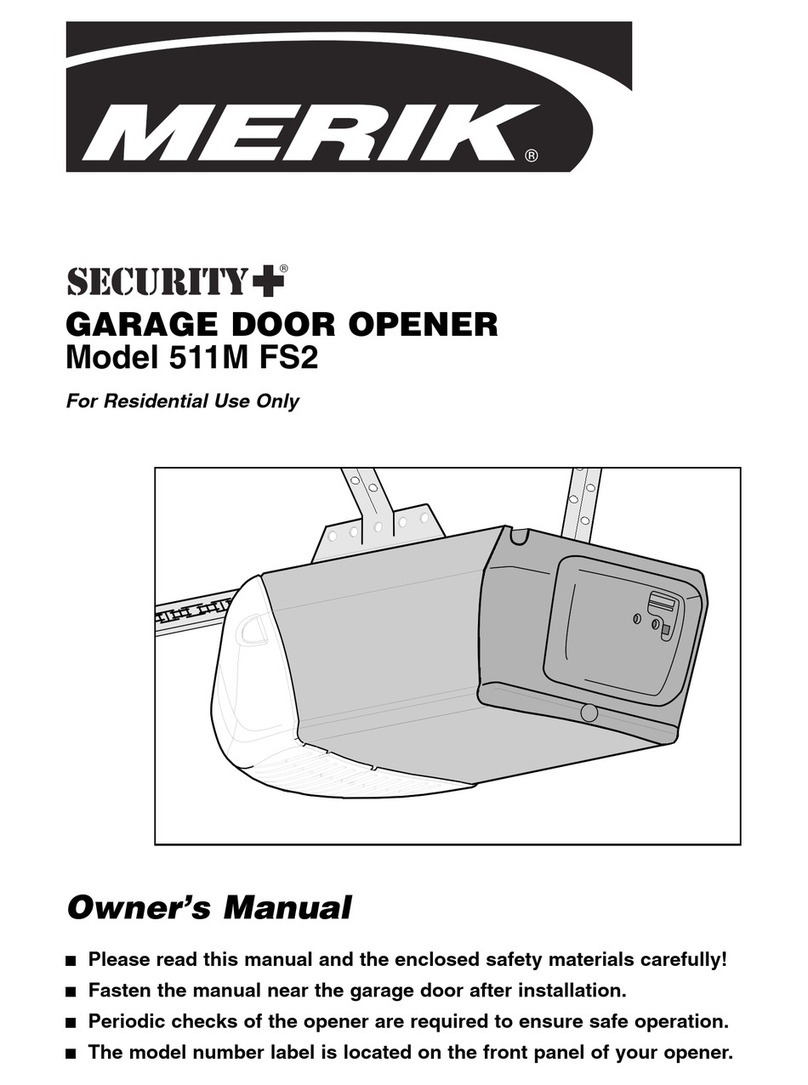
Merik
Merik 511M FS2 User manual

Merik
Merik LiftMaster PREMIUM Series User manual
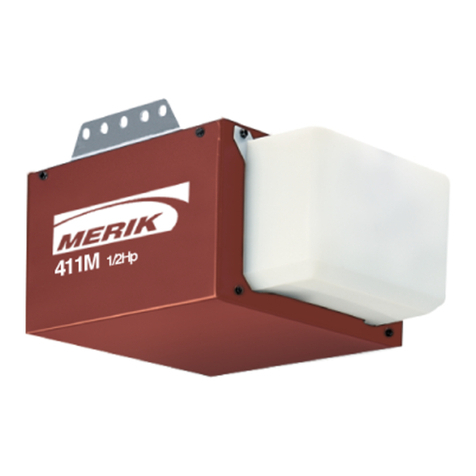
Merik
Merik Security+ 411M User manual

Merik
Merik 511MM FS2 User manual

Merik
Merik LiftMaster 7511LMK User manual
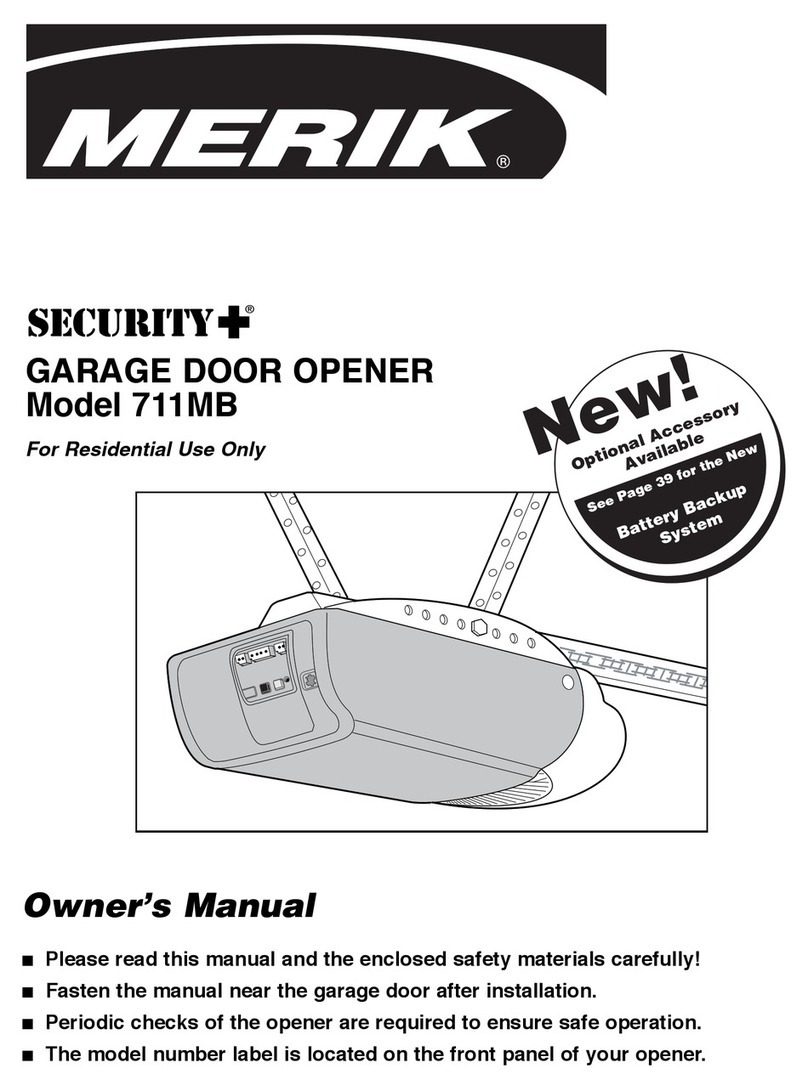
Merik
Merik 711MB User manual
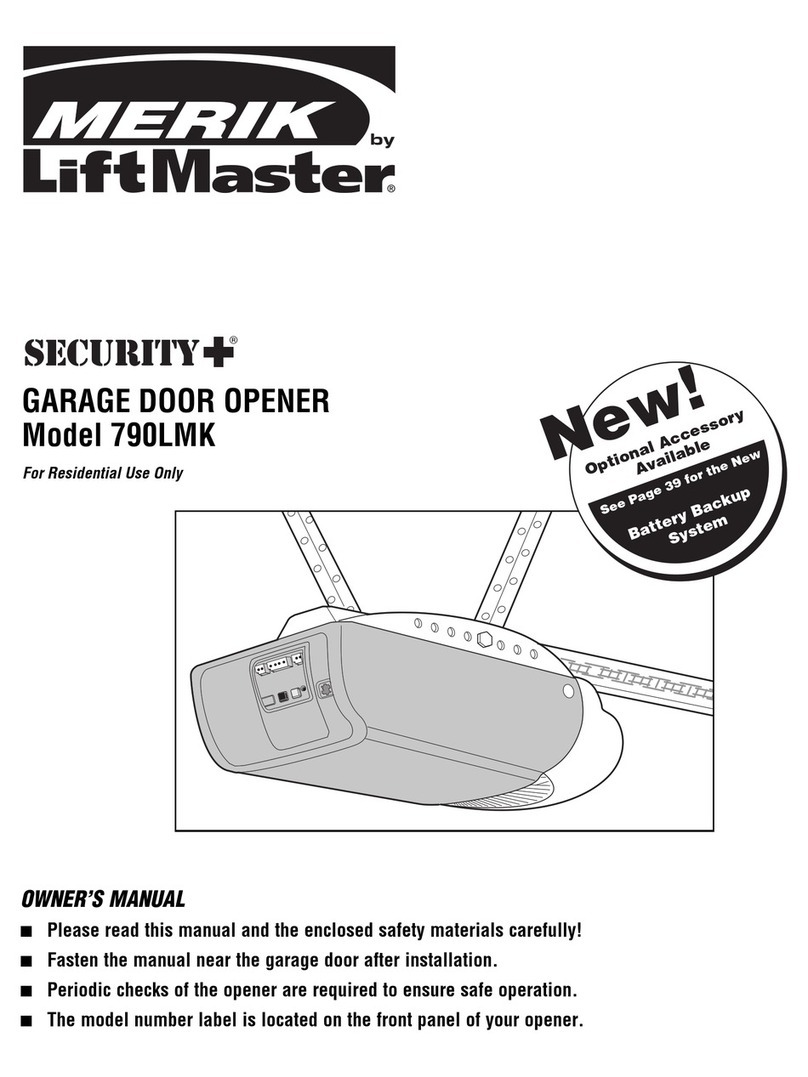
Merik
Merik 790LMK User manual
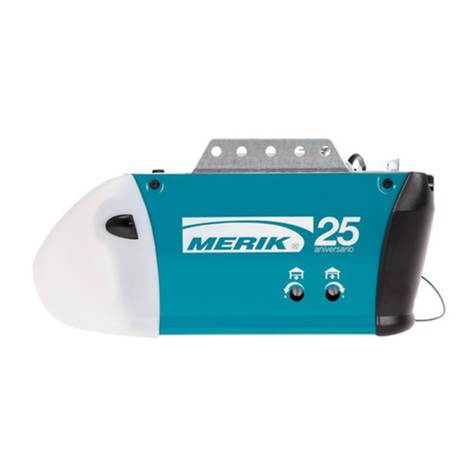
Merik
Merik 511MM FS2 User manual
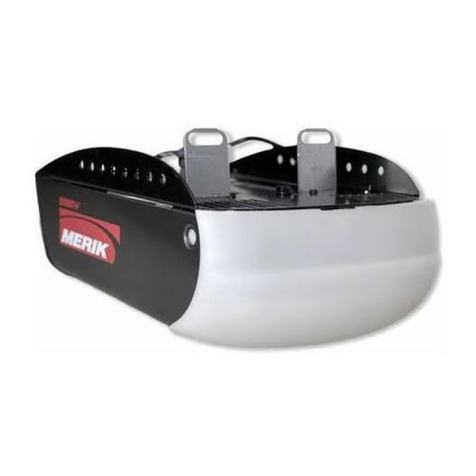
Merik
Merik Security+ 711MD User manual
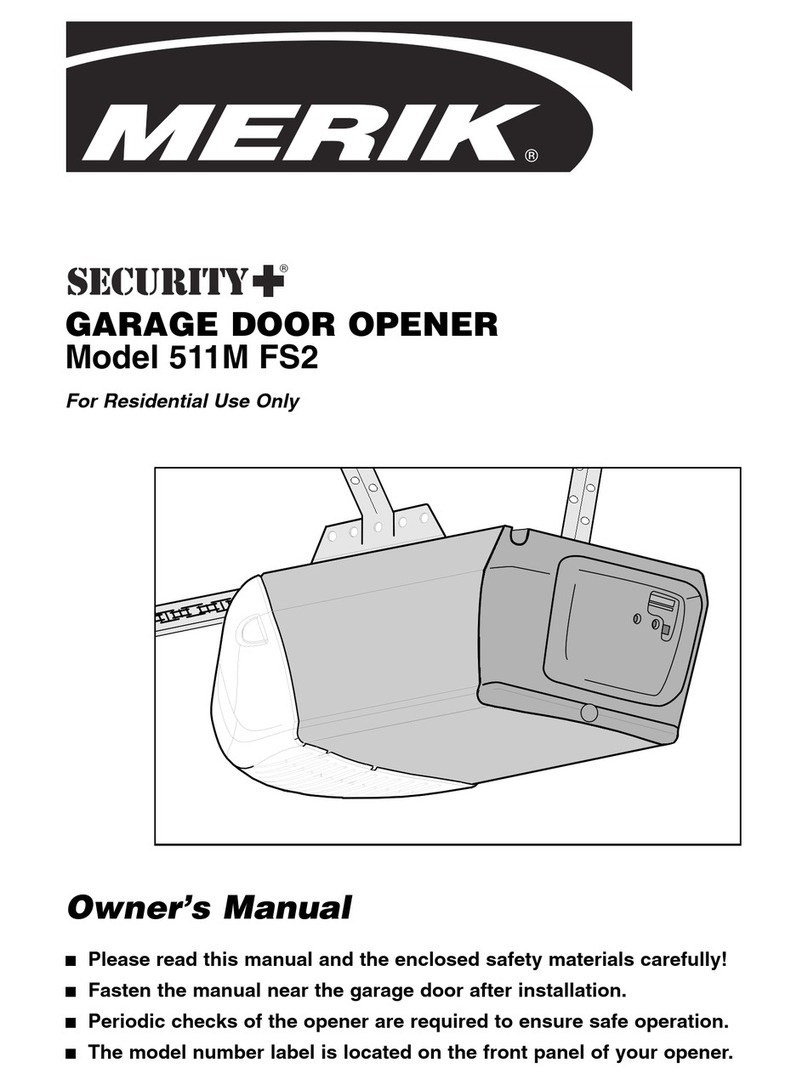
Merik
Merik 511M FS2 User manual

